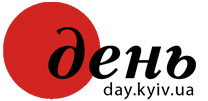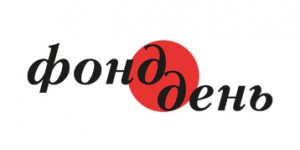The small village of Bobrytsia (its population totals around 500 people) begins exactly 20 kilometers away from the Kyiv city area. This is why there is little space on both sides of the road that runs to it. Plenty of newly-built “villas” are standing along the roadside.
It would seem that Bobrytsia’s genuine things would be totally absorbed by the capital and it would be transformed into new suburbs, without a hint of a typically provincial, calm and quiet atmosphere, because the village is located so close to the capital. Yet Bobrytsia has preserved this atmosphere, albeit the powerful breath of the megalopolis has its effect. It is especially felt in autumn, when the village hosts a festival of traditional culture, Rozhanytsia. But on February 7 Bobrytsia is quiet. The village’s residents respect the democratic procedure that, as is known, does not like noise. Only colorful wedding trees remind of traditional autumn celebrations and contrast with the white snow and conservative outlines of the recently built Orthodox church.
Bobrytsia owes its conserved traditional spirit partly to the enthusiasts and local lore researchers, who are persistently studying the village’s history, collecting photos and documentary materials. Already in spring these Bobrytsia archives will be put on display at the local lore museum arranged in a former village club.
The traditional spirit is combined with a part of modern Europe — Bobrytsia sports a football field with a high-quality surface (perhaps the only one of its kind in the Kyiv Sviatoshyno district), which, you must admit, is quite an exotic detail for Ukrainian countryside landscape.
Land is no longer viewed as a source of survival in Bobrytsia. The local descendants of the “grain-growing civilization” have lost the connection between the notions of land and man. Instead they have acquired another one — that between land and profit. Across Ukraine hundreds of land hectares are still unused, here every centimeter is worth its weight in gold, in the literary sense of the word. So it is not simple for the Bobrytsia village chairman Vladyslav Danchenko to manage it. That is precisely why Danchenko ponders the land question in Ukraine in a pragmatic way, through figures, names, and titles of resolutions. He has no illusions about the new power and pins no romantic hopes on it. He believes that a substantial change to the situation will be brought by the new generation with new mentality.
It seems that to a large extent Danchenko also belongs to the new generation, as well as the efficient and pragmatic part of society which keeps the entire country afloat, taking care of its ethnic culture and, simultaneously, the newest surface for sports grounds.
A Bobrytsia-born village chairman, who is a historian by education, has been in this office since 2006. A year before that Danchenko came second in the “race for the post of mayor” in the town of Boyarka, which is located near Kyiv, where he has lived for a while. After winning “silver” there, the young politician decided to return to his small homeland to implement changes in the country starting from Bobrytsia.
Mr. Danchenko, today I can say that the name of the next president of Ukraine is already known. As for the next five years, different hypotheses are expressed, but no matter what the country’s political situation is the Ukrainian society has many times proved its viability. Although we depend on politicians and politics to a large extent, not everything is decided from above. Society rests not on the walls of the statesmen’s offices, but on the shoulders of those who work for their own development and the development of their social environment. On whose shoulders does Bobrytsia rest? It is known that among your co-villagers there are people who study its history and publish books about it.
“Many materials about the village’s history have been preserved by the former local teacher Liudmyla Hrekova. With the help of the local lore researcher Mykola Kovalchuk we have published a book dedicated to Bobrytsia’s history based on these materials, An Immortal Part of Ukraine – My Small Bobrytsia. Many people have responded to the idea to create this book and have provided materials from their family archives. Kovalchuk has gathered a unique collection of photographs, a total of nearly 2,000, which he now keeps at home. In order to provide visual demonstration, we decided to establish a local lore museum already this year, in spite of the fact that the year 2009 was marked with a crisis and was quite difficult in terms of financing. The museum of the village’s history will not simply be premises to keep archival materials. We plan that it will grow into a sort of cultural-artistic center of the village’s spiritual life with pottery and embroidery master classes and folk art groups.”
Will this cultural-artistic center be partly receiving the guests of the wedding tradition festival, Rozhanytsia, which was held for the third time in Bobrytsia last year?
“Surely. But the festival lasts only for a couple of days, whereas we would like the festival life to thrive in Bobrytsia, or at least a part of it, throughout the year. Preserving this spirit will become the major mission of the cultural-artistic center created on the museum’s base.
“As for the Rozhanytsia festival, which we founded jointly with Roman Korniienko, director of the Choven Theater, it is a part of the program of green tourism development in Bobrytsia. Our village has a unique landscape and environment, it is surrounded by forests, lakes, and the Irpin River is located nearby. This area is one of the safest in the Kyiv region. No industrial objects are situated here. So it has quite a high potential for development of green tourism. We have tremendous plans. The main thing is to involve the village residents in their realization.
“The noted artist Volodymyr Sliepchenko lives and works in Bobrytsia. His gallery-house is located here, and we often invite the guests of the village to come to it. It will also become a part of the cultural-artistic space. We view all of these objects as a complex of Bobrytsia’s attractions.
“Since last year we have had several projects that have not been realized yet, specifically a kindergarten. No money has been allotted from the budget for its construction, so we pinned our main hope on investors, constructors who come to the village and receive land plots. But they were impeded by the crisis, although it was not the main obstacle. First and foremost, this was a constant change of normative-legal acts on privatization, legalization, necessary documentation, and so on. Bobrytsia is a fairly special village. Its special feature is its location near the capital. As you understand, a big role here is being played by the factor of the land price. The high price defines relations both inside Bobrytsia, between its residents and the village council, and those between the raion administration and the village council. The price for land is a decisive factor in relationships among all these institutions. Therefore, for our village it is important that the laws on land be clear-cut and easy to understand, so that the Land Code would not be rewritten several times a year, and the ‘rules of the game’ would be transparent. The formula of successful development of our village is very simple: Don’t hinder us from developing!”
Is the realization of this formula the main hope you pin on the next president of Ukraine?
“Yes. We expect that the person to head the raion administration will be of local origin, i.e., that he or she understand the local situation. Regular personnel replacements in the leadership of the administration of the Kyiv-Sviatoshyn district, which took place under the previous president, are not favorable for stable development.”
In your opinion, what policy should the new president pursue regarding Ukrainian villages on the whole?
“There is a need to establish a legislative framework that would allow citizens to have their land at their free disposal and prevent any kind of manipulations or non-transparent schemes that would make it possible to take away the villagers’ land shares.”
Ukraine’s oldest village of Bilohorodka is located near Bobrytsia. It was founded before Rus’ was baptized by Volodymyr in 980. Bobrytsia, too, has ancient history. How is it felt by the present-day residents? Do they preserve their traditions? Due to close location to the ever-growing capital the number of new residents is constantly on the rise, which may wash off the “traditional landscape.”
“For a long time Bobrytsia has remained a part of the Bilohorodka Village Council, which has made a certain imprint on the ‘smaller brother’ and was not helpful for the development of culture whatsoever. But after the Bobrytsia Village Council was established in 1995, the village started to revive; it came back to life, both in terms of economy and culture. For example, today our chorus is known widely beyond the raion; it takes part in many festivals and is a winner of many festivals.
“I cannot say that many young people reside in Bobrytsia. But I can say for sure that youth does not often leave the village, rather vice versa: it is growing in number as new people arrive. On the one hand, they indeed wash off the ‘traditional landscape,’ but on the other hand, specifically owing to the Rozhanytsia Festival, they themselves become part of this landscape. As they become Bobrytsia’s residents, they bring their family stories, lives, traditions, and colors, thus adding to the history of our village.”







